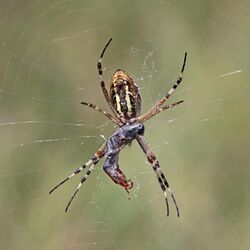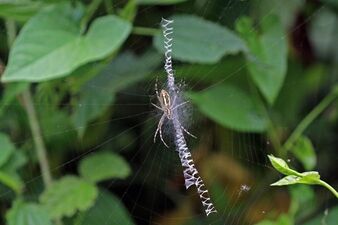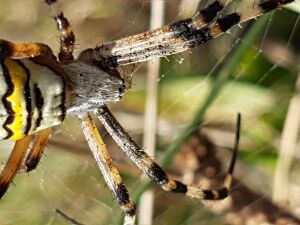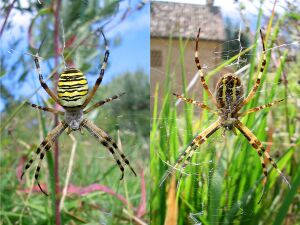Biology:Argiope bruennichi
| Argiope bruennichi | |
|---|---|

| |
| Dorsal side | |

| |
| Ventral side with prey in Hungary | |
| Scientific classification | |
| Domain: | Eukaryota |
| Kingdom: | Animalia |
| Phylum: | Arthropoda |
| Subphylum: | Chelicerata |
| Class: | Arachnida |
| Order: | Araneae |
| Infraorder: | Araneomorphae |
| Family: | Araneidae |
| Genus: | Argiope |
| Species: | A. Bruennichi
|
| Binomial name | |
| Argiope Bruennichi (Scopoli, 1772)
| |
| Synonyms | |
|
List
| |
Argiope bruennichi (wasp spider) is a species of orb-web spiders distributed throughout Central and Northern Europe, North Africa, parts of Asia, and the Azores archipelago.[1] Like many other members of the genus Argiope (including St Andrew's Cross spiders), it has strikingly yellow and black markings on its abdomen.
Web
The spider builds a spiral orb web at dawn or dusk, most often in long grass just above ground level. The zigzag-shaped web decoration, the stabilimentum, featured at the centre of the orb, is of uncertain function, though it is often It has been shown that webs containing stabilimenta are less often damaged by birds flying through them.[2][3]
When prey gets trapped in the web, the spider immobilizes it by wrapping it in silk. The prey is then bitten and injected with a paralyzing venom and a protein-dissolving enzyme.
Population
During the Summer of 2006, research found there had been an influx of these spiders in the United Kingdom .[4] The coloration of this population is similar, although the yellow stripes are more cream-colored.
Besides the nominate subspecies, there is one subspecies currently recognized:
- Argiope bruennichi nigrofasciata Franganillo, 1910 (Portugal)
Sexual dimorphism
Argiope bruennichi are distinct between males and females. The males averaging length of approximately 4.5 mm and females averaging 15 mm.[5] The reasons for these differences in size seem to have evolutionary and fitness backgrounds, with regards to mating, as well as female cannibalisation on males after copulation.
Mating
The size difference of the male spiders allows males to come into contact with females, in relation to their orb webs. The male Argiope bruennichi is able to enter into the female's orb and thus make their webs without being detected as prey and eaten before they are able to mate, a major fitness advantage.[5]
Plugging
Certain male Argiope bruennichi have an adaptation that they have developed to ensure that they will be the only mate with whom the female can produce offspring. Certain males are able to "plug" the female after they have mated with her to prevent other males from copulating with the female. This plugging involves losing one of his pedipalps, thus allowing him to only mate twice. This is a major reason as to why these males are always in a rush to mate after the female has completed her final moult.[6] With males always waiting around for the female to reach full maturity, the race is on for the male who is small enough to not be detected, yet is also able to "plug" the female so that other males have a lower chance of competing for fertilization of her eggs. These spiders have evolved to become monogamous for the most part after mating because of this damage.
If the females are only able to reproduce once they must develop a method to produce more offspring at one time (per clutch). This can be caused by multiple things, including a sex ratio that forces these males to make sure they have at least one female to produce their offspring simply because there are not as many females present.[7] If these females are only able to mate one time, they need to develop this larger clutch size to ensure that their genes are passed down from the surviving of her first clutch.
Females that consumed a small supplement of dietary essential amino acids produced offspring that survived simulated overwintering conditions significantly longer than offspring of other treatments. Results suggest that dietary essential amino acids, which may be sequestered by males from their diet, could be valuable supplements that increase the success of the offspring of cannibalistic females.[8]
Cannibalism
Argiope bruennichi participate in sexual cannibalism. The females of this species, typically much larger than the males, almost always consume their male counterparts after copulation.[9][6]
To combat this, males often wait in or near an immature female's web until she completes her final moult and reaches sexual maturity. After moulting, the female's chelicerae will be soft for a short period and the male may mate without the danger of being eaten.[10]
References
- ↑ "Argiope bruennichi at the Azorean Biodiversity Portal". http://www.azoresbioportal.angra.uac.pt/listagens.php?lang=en&myFilo=ARTH&pesquisar=Argiope&start=1&end=40&sstr=8&id=A00576.
- ↑ "Banded Garden Spider: Argiope trifasciata". North American Insects and Spiders. http://www.cirrusimage.com/spider_argiope_trifasciata.htm.
- ↑ Blackledge, Todd; Wenzel, John (1 July 1999). "Do stabilimenta in orb webs attract prey or defend spiders?". https://academic.oup.com/beheco/article/10/4/372/2252323.
- ↑ Jonathan Amos (3 October 2006). "If one crawls across the carpet...". BBC News. http://news.bbc.co.uk/2/hi/science/nature/5394338.stm.
- ↑ 5.0 5.1 Mark A. Elgar (1991). "Sexual cannibalism, size dimorphism, and courtship behavior in orb-weaving spiders (Araneidae)". Evolution 45 (2): 444–448. doi:10.2307/2409679. PMID 28567867.
- ↑ 6.0 6.1 Stefan H. Nessler; Gabriele Uhl; Jutta M. Schneider (2006). "Genital damage in the orb-web spider Argiope bruennichi (Araneae: Araneidae) increases paternity success". Behavioral Ecology 18 (1): 174–181. doi:10.1093/beheco/arl074.
- ↑ Jutta Schneider; Lutz Fromhage (2010). "Monogynous mating strategies in spiders". in Peter Kappeler. Animal Behaviour: Evolution and Mechanisms. Springer. pp. 441–464. doi:10.1007/978-3-642-02624-9_15. ISBN 978-3-642-02623-2.
- ↑ Shawn M. Wilder; Jutta M. Schneider (2017). "Micronutrient consumption by female Argiope bruennichi affects offspring survival". Journal of Insect Physiology 100: 128–132. doi:10.1016/j.jinsphys.2017.06.007. PMID 28614727.
- ↑ Lutz Fromhage; Gabriele Uhl; Jutta M. Schneider (2003). "Fitness consequences of sexual cannibalism in female Argiope bruennichi". Behavioral Ecology and Sociobiology 55 (1): 60–64. doi:10.1007/s00265-003-0656-6.
- ↑ "Wasp spider | The Wildlife Trusts" (in en). https://www.wildlifetrusts.org/wildlife-explorer/invertebrates/spiders/wasp-spider.
External links
- Ella Davies (22 March 2013). "Cold-tolerant wasp spiders spread to northern Europe". BBC Nature. https://www.bbc.co.uk/nature/21877948.
- "Argiope bruennichi". Fauna Europaea. 2004. http://www.faunaeur.org/full_results.php?id=178833.
- Daiqin Li (2005). "Spiders that decorate their webs at higher frequency intercept more prey and grow faster". Proceedings of the Royal Society B: Biological Sciences 272 (1574): 1753–1757. doi:10.1098/rspb.2005.3160. PMID 16096085.
Wikidata ☰ Q902450 entry
 |






